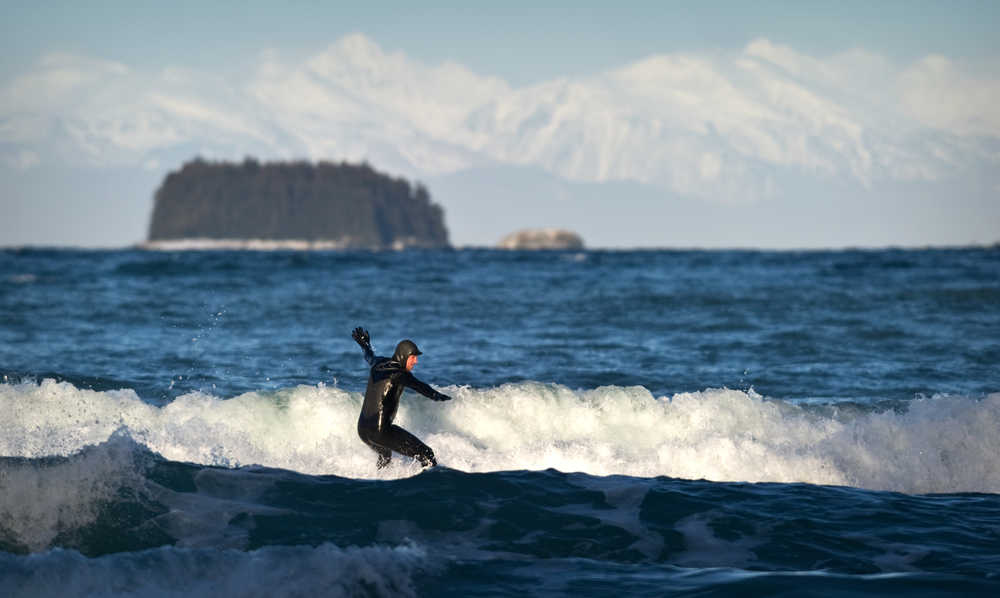2015 was another great year to be hiking, boating and in general being in Southeast Alaska (well… aren’t they all?) But as we looked through the articles of the past year, we couldn’t help but notice quite a few articles about unusual events — songbirds identified for the first time in the state, or a strangely warm Gulf of Alaska, for instance. Here are some of the highlights from 2015’s Outdoors section.
Feb. 5
The tailings dam at Mount Polley Mine in British Columbia failed in August of 2014, releasing billions of gallons of toxic water and tailings into the Quesnel Lake watershed, devastating the fishing run for First Nation peoples in the area, and galvanizing Southeast Alaskans’ opposition to British Columbian mines in transboundary watersheds. Early in 2015, an independent panel came out with a report that called for an end to “business as usual” and updates to 100-year-old tailings dam technology. According to current statistics, two B.C. mine dams will fail every 10 years, the report said, and best practices should not be trumped by economic considerations.
BC governmental representatives have since said they are following the panel’s recommendations. In August, they traveled to Juneau to hear concerns and talk about what they’re doing.
http://juneauempire.com/outdoors/2015-02-05/mount-polley-report-two-dams-expected-fail-every-10-years-southeast-alaskans-say
March 13
Carver Wayne Price and the U.S. Forest Service have been working to repair Yax té totem, the totem pole located at Auke Recreation Area. It’s suffered from bullet holes, woodpeckers and rot over the last 20 years. In the process of renovating it, Price found a time capsule message from the last carver to work on the pole.
http://juneauempire.com/outdoors/2015-03-13/yax-t%C3%A9-totem-begins-life-anew
http://juneauempire.com/outdoors/2015-03-13/decades-old-time-capsule-found-inside-local-totem
May 1
The steelhead in Yakutat’s Situk River aren’t breaking news, but they sure are fun to chase.
http://juneauempire.com/outdoors/2015-05-01/catching-chromers-yakutat
July 17
The Gulf of Alaska is changing, with unusual species showing up, much warmer than normal temperatures, and unusual toxic algae blooms — something that worries scientists near and far.
http://juneauempire.com/outdoors/2015-07-17/sea-changes-warm-gulf-leads-unusual-happenings-worried-scientists
August 7
A short but sweet story: this year at Eaglecrest Ski Area, Juneau’s mountain bikers got their first dedicated mountain bike trail, courtesy of volunteers, donations and a working relationship between the Juneau Mountain Bike Alliance and Eaglecrest.
http://juneauempire.com/outdoors/2015-08-07/juneaus-first-dedicated-mountain-bike-trail-underway
August
In August, B.C. Minister of Mines and Energy Bill Bennett and a team of fellow B.C. representatives came to Juneau (and later Ketchikan), to talk with tribes, local residents, Lt. Gov. Byron Mallott and others concerned about transboundary mines – British Columbian mines in transboundary watersheds. Those talks resulted in the mutual decision to develop and sign a nonbinding statement of cooperation better outlining the way Alaskan and B.C. officials work together, and establishing new protocols. Bennett also promised to take action to clean up the Tulsequah Chief, which has been leaching acid mine drainage into a tributary of the Taku River for decades. On Dec. 11, Salmon Beyond Borders and tribal representatives submitted their final comments on the first iteration of the province’s and Alaska’s statement of cooperation, and say that while the statement isn’t a bad move, they still want Alaska to ask for the involvement of the International Joint Commission, or IJC, which regulates disputes under the Boundary Waters Treaty of 1909, asking why Alaska wouldn’t use “the best tool in the toolbox.”
http://juneauempire.com/local/2015-08-26/bc-mines-minister-talks-transboundary-mines-tulsequah-chief-cleanup
http://juneauempire.com/state/2015-08-27/bc-alaska-draft-mou-mine-processes
http://juneauempire.com/local/2015-08-28/qa-bill-bennett
http://juneauempire.com/state/2015-08-27/after-bennett-visit-groups-are-cautiously-optimistic-progress
Sept. 3
The Taku Glacier is the only glacier on the Juneau Icefield to be advancing. According to the Juneau Icefield Research Program’s measurements over the last few years, however, the overall advance of the 9-kilometer-wide glacier snout has stagnated. That may only be temporary — or it may be a harbinger of the icebergs soon to float past Juneau’s downtown docks.
http://juneauempire.com/outdoors/2015-09-04/taku-glaciers-advance-stagnates
Sept. 25
In less than a week’s time, two southern songbirds were seen for the first time ever in Alaska. Fourteen-year-old Owen Squires identified a hooded oriole, more common in Mexico than Alaska, in the Juneau Community Garden. Then park rangers identified a yellow-throated warbler in Glacier Bay. The reason? Well, it could be climate change, habitat destruction, more people paying attention or bird dyslexia. Basically, no one’s sure.
http://juneauempire.com/outdoors/2015-09-25/14-year-old-ids-hooded-oriole-juneau
Oct. 16
Palm trees in Southeast Alaska? It sounds far-fetched, but 50 million years ago they were here (along with an ancient, three-toed ancestor of the horse). Southeast scientists’ research into the fossil record shows it.
http://juneauempire.com/outdoors/2015-10-16
Dec. 4
Auke Bay was the wildest it’s been in decades in early December, with hundreds of common murres, marbled murrelets, loons, sea lions, seals, and even two humpback whales — all there for the gathering of herring and pollock.
Dec. 11
Sometime in the near future, the Mendenhall River will keep starting and stopping in the same place, but it will get a half-mile shorter. Wait, what?
http://juneauempire.com/outdoors/2015-12-11/mendenhall-river-soon-shorten-then-lengthen
• Mary Catharine Martin is the Outdoors editor. She may be reached at maryc.martin@juneauempire.com

